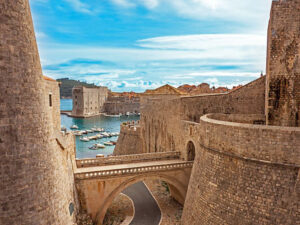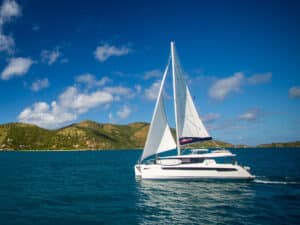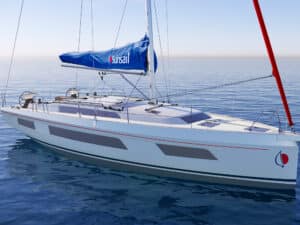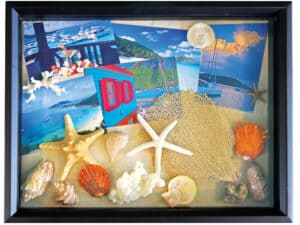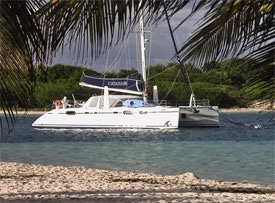
FeatMurphySt
An early morning in July: I was running late for a plane, still scurrying around the house, when I stopped one last time to check e-mail before heading out the door. Most of the messages were of small account, but one among them was less easy to ignore. It came from my friend Anny Rey in Munich.
“I woke up this morning dreaming about us meeting again,” she wrote. “I was landing in a plane, and you came to pick me up. It was not an airport kind of meeting, but a tarmac kind of meeting, and you were not supposed to be there, making das Wiedersehen all the more intense. The feeling of joy was so deep that I continued to doze off, feeding on this wonderful warmth.”
On any other day I would have answered her immediately. We would have had a nice exchange, and that would have been the end of it. But on this day I didn’t have the time. Instead, as I loaded my bags into the car and merged onto the highway and made my way through the airport, Anny’s dream stayed with me. And it lingered through the rest of the week that followed. It was another 10 days before I was back to my desk and able to respond. By then, an idea had taken root. Anny’s 40th birthday was coming up: We needed to go sailing.
And so it began that an unlikely quintet of fellow travelers-a Belgian girl I’d first met some 20 years earlier at a police station in Paris, my 6-year-old daughter, and a pair of Frenchmen none of us had ever before laid eyes upon-gathered for a week of sailing among the Caribbean islands around Guadeloupe.
Exciting Marks
A breezy afternoon in November: The Catana’s 2,100 square feet of working sail were sheeted tight and filled with the easterly trades as we scooted from Pointe a Pitre to Marie-Galante through 15 miles of unhindered Atlantic rollers.
“I’m going to have so much stuff to write in my travel journal!” Kate yelled over the wind. We were just hours into our crewed charter aboard the 58-foot catamaran Alidade, and already my daughter was bursting with things to tell her first-grade class: about snorkeling off the boat behind Îlet du Gosier, about watching a pair of kayakers negotiate the surf near the reef, about eating a tuna salad made with a fish that hadn’t come from a can, and now about wave riding near the bows of a giant cat.
The day before, we’d rented a small Renault and driven counterclockwise around Basse-Terre, the higher of Guadeloupe’s pair of main islands. At its heart is Soufriere, an active volcano that climbs 4,800 feet into the clouds, wringing out the rain that feeds a lush national forest and a series of spectacular waterfalls called the Chutes du Carbet-our goal for the day. Guadeloupe is a full-fledged department of France, and by Caribbean standards, its roads are surprisingly good. But once you leave the highway that rings Basse-Terre and you begin to climb toward the head of the trail that leads to the waterfalls, it becomes instantly clear that while plenty of public money has been spent on putting down the asphalt, comparatively little has gone toward leveling the grades. A regular rhythm of hillocks set against the D4’s general incline gives the road a roller-coaster feel.
“Every time your tummy gets tickled,” Kate suggested on our way up the mountain, “yell ‘Woohoo.'”
“Woohoo! Woohoo! Woohoo!” we three yelled all the way back down.
Now under way aboard Alidade, Kate and Anny and I were sitting just forward of the mast with our feet on the netting that spans the gap between the hulls of the 58-foot cat. Every so often, an impish wave would rise up and-if we didn’t instantly clear our feet away-try to soak us. “Woohoo!” Kate shouted between giggles. “This is even better than the car! Mom and Max would be throwing up right now.”
Alas, she was right. My wife and 14-year-old stepson are happy to go out sailing for a warm afternoon on flat water, but for them, the fun stops with the first waves. This wouldn’t be their kind of day. Kate, on the other hand, has been joining me on sailboat outings ever since she was an infant; now, at 6, she’s an all-weather companion, and when this trip came together, I wanted to give her a taste of Caribbean sailing. Granted, it meant pulling her out of school for a stretch, but fortunately her teacher was hip to the benefits. Mrs. Grinnell sent Kate off with a notebook, a brand-new box of colored pencils, and instructions on the kinds of stories to bring back to her class.
“We saw a rainbow, and I saw the pot of gold!” reads one illustrated page. “We saw eight!!! We saw over 10!!!”
Another page tells of wave riding. “This is the best boat I have ever sailed on!!! We got splashed!! And it was fun!!!”
Kate is an enthusiastic kid. She’s also new to writing, and after a few pages like these, I suggested that she might achieve a more powerful effect if she used her exclamation points more sparingly. That advice held through her next few entries: about a strange star we saw in the western sky, and about a bull we heard across the water that “sounded weird.” But a couple of days later, inside the pristine and deserted lagoon at Petite-Terre, when Captain Dan Segalowicz taught her to operate a kayak, well, all my words were moot.
“Dad, he showed me how to paddle in a U all by myself,” she said. “I have to use exciting marks!”
Barefoot in Capesterre
Dan Segalowicz is an excellent guide to the French Caribbean islands and a fine teacher. He’s spent most of the last 10 years based in the Caribbean, working for such bareboat-charter outfits as Stardust and Sunsail, and, now on his own, principally running Alidade. Beyond the more obvious sailing-specific local knowledge he brought us, he also opened the window onto Guadeloupe’s Creole culture.
“See them?” he asked one evening, pointing to a pair of magnificent frigate birds on a fishing expedition.
“The locals call them ‘malfinis’-the French word for ‘unfinished.'” He went on to unravel for us the mystery of Guadeloupe’s place names: why, for instance, Basse-Terre, which means “low land,” describes a high, mountainous island, while Grande Terre clearly is the lower of the pair of main islands.
“Sailors named these islands,” he said. “‘Basse’ is talking about its place in the wind, not how high it is. Basse-Terre is the island that’s downwind.” Same goes for the two main islands of Les Saintes: Terre-de-Haut and Terre-de-Bas. The high and the low are all about the wind.
Perhaps Anny and I should have recognized these words ourselves: She’s a native French speaker from Belgium, and I spent all my school years majoring in French. In fact, we were both 20 and studying in Paris in 1986, the year we met. The scene of our meeting was a chaotic police station. Paris had just undergone a series of bomb attacks, and the French government was tightening its restrictions on foreigners entering the country. I was at the precinct headquarters, hoping to secure a residency permit. I was flipping through a thick file of documents, translated and in triplicate, when disaster struck: I dropped the file. Its entire contents scattered into the crush of immigrants. From behind me a lightly accented voice said in English, “Are you from the U.S.?” and Anny, alone among that crowd, helped me out of the bind. We’ve been inseparable pals ever since.
But, clearly, all we knew of French still left us without much context for Creole. Over glasses of Ti Punch, Guadeloupe’s signature rum drink, Dan’s lessons in the local lingo continued. “Many names reappear throughout all these islands,” he said. “Take ‘Marigot.’ It means the floodplain near the mouth of a river. In St. Lucia and St. Martin and Haiti and here in Les Saintes, Marigot is always near low land at the base of the mountains. Or another one: Many of these islands have a place called ‘Capesterre’-‘cap,’ ‘est,’ ‘terre.’ It’s always a cape on the east [“est”] side of an island.”
Indeed, he said, Capesterre on Marie-Galante has one of the finest beaches in the Leeward Islands, with a string of colorful reefs just offshore. Following his advice, on the next day Anny, Kate, and I rented a car (33 euros per day for a newish Citroen) and crossed from Port Saint-Louis to Capesterre-a distance of less than 10 miles as the malfini flies.
Marie-Galante is an agrarian island, an idyllic island, where sugar cane still defines the setting. It’s here, of all the places Dan has visited in his wandering life, that he’d choose to settle when that time comes. Take only a few steps inland from the peopled coastline, and you find yourself in a world of buffalo-drawn carts and cottage distilleries and windmills that within the span of living memory were replaced by internal-combustion plants. Driving across the middle of the island, and almost despite the excellent condition of the one- and two-lane roads, we truly felt we’d crossed into another time. For Kate, walking through stalks of sugar cane was like strolling into a fairy tale. Yes, love: Sugar really does grow on trees.
As for the beach at Capesterre, we’d packed our masks and fins to swim among its coral, but a late-season tropical wave had drawn the trade winds south of east and sent a big surge over the reef. Instead, between squalls we took off our shoes and contented ourselves with a long walk in the sand. While Kate and I played at the surf’s edge, Anny went for a longer stretch around Pointe de la Feuillere. When she found us a while later, she put her arm around me and, her eyes smiling, said, “I can turn 40 now.”
We were three days into the trip, and she was still shaking off a mother’s hangover resulting from the all-nighter she’d pulled with her two children, ages 10 months and 3 years, followed by a full day of transatlantic flying and a five-hour time change. She felt that this kind of trip was probably too intensive for even her 3-year-old to enjoy-Cyril and Kate get along well together, despite their language gap (he speaks French and German; she’s still an English-only kid)-so Anny left them in Munich for a week of daddy care.
When we returned to Alidade that evening, chef Mathias Perier had a surprise waiting for Anny. Throughout the trip, he’d been wowing us with delicious, beautifully prepared meals-a rainbow of roasted peppers interspersed with thinly sliced buffalo mozzarella, local snapper a la papillote, a bottle of chilled Brouilly to accompany grilled cotelette de porc, homemade pesto, creme caramel made from local vanilla beans-but this time he’d truly found the way to stir Anny’s Belgian soul. Mathias reached into the cooler and produced a 330-milliliter bottle with a yellow label.
“Leffe!” she cried, as he opened the ale. “I don’t ever get this in Germany. Now this is really luxury!”
Kate was charmed by Mathias not so much for his culinary magic as his gymnastic sense, for he it was who showed her the true uses of the Catana’s tween-the-hulls netting: This trampoline was made for jumping. So, glasses filled, we followed Kate to the foredeck, where we bounced and danced in our bare feet to the groovy tunes of Dan’s CD collection. When the surfer-bard Jack Johnson came on, Anny burst out laughing. The first time she’d heard him was a year earlier with me, during a beach week that our families spent together. Back at home after that vacation, she bought three of his albums-and inadvertently set off a winterlong music war with her toddler son. During their car rides through the congested Munich traffic to or from daycare, every time she played Jack Johnson, Cyril would say, “I want J.J. Cale.”
Cyril’s dad is a longtime fan of road trips, especially American road trips, and for him the best road-trip music has always been J.J. Cale. Cyril is his daddy’s boy.
“For me, though,” said Anny, “listening to Jack Johnson is like walking barefoot. When I’m on holiday and walking barefoot, I feel like I find the best part of myself. But I can’t walk barefoot in my life in Munich. Jack Johnson brings me a part of that barefoot feeling for more than just a week.”
The Bird and the Cage
Bare feet and bathing suits were the dress code at Petite-Terre, a national park that’s uninhabited but for the boatloads of daytrippers who come for a few midday hours. When the last of the headboats left around 4, we had the place entirely to ourselves-unless you count the island’s 10,000 iguanas, common and antillean, that live there amid the native rosemary. The island’s only edifice is a 19th-century lighthouse built from the ballast of European ships. Petite-Terre is actually two islands with a reef across the windward opening; Guadeloupe’s government provides moorings in the lagoon to keep the coral whole.
Toward sunset, with our snorkels and masks we took the dinghy to the surf line, then popped over the side and rode the current back down to Alidade, immersed in a first-class view of God’s own aquarium. It was a lovely place to have to oneself.
Here, the days of our trip found their natural routine. At intervals between paddling or snorkeling or beachcombing or hiking, Dan would take Kate aside and teach her things: sometimes about French words, sometimes about boat words, sometimes how to do things aboard a boat. For dinners he’d join us, and we’d talk about the places we’d been and lived and those we’d like to see. And on the few evenings when Kate didn’t outlast me at bedtime, Anny and I would lie on the trampoline under the stars, talking and remembering and untangling each other’s inner riddles, as we’ve been doing now for half our lives.
And woven through all these things was the sailing. Our passage to Petite-Terre had already shown off the Catana’s true colors. The same tropical wave that pulled the trades south and sent the surf over the reef at Capesterre was now working in our favor: In what Dan said was a rare treat, we were able to lay Petite-Terre from Marie-Galante in a single tack. With a reef tucked in the main and the daggerboards down, we sailed some 50 degrees off the wind and enjoyed double-digit boat speed along the way. While Anny steered, playing the telltales against the Atlantic rollers, Kate and I went into the forward cabin, where the hatches offered a waterline view of the big cat’s ride through the waves. One moment, we’d see the opposite bow rise completely out of the water; the next, we’d be looking into a blur of blue and white. From that vantage, we could see the Catana’s midships bulb in the nacelle break up the few waves that reached the underside of the bridgedeck; Alidade never pounded, as some cats do. Indeed, this was one of those rare catamarans that was decidedly fun to sail to windward.
Later in the week, under similar conditions, we’d crack off to a reach and see just how comfortably Alidade reeled in over 13 knots, mile after mile. If Alidade had any disappointing point of sail, it was off the wind. She isn’t fitted with the sprit that’s typical of many cats, and she didn’t have a viable cruising spinnaker, so for the 25-mile sail from Petite-Terre to the Saintes, after jibing downwind under working sails for a while, we resorted to the iron contingency plan.
For all of Petite-Terre’s pristine beauty, the charm of the Saintes comes from the people who’ve settled these islands, adventuresome fishermen from Brittany. The harbor off Bourg des Saintes is mountainous on three sides, its hills decorated by colorful, well-maintained homes with sprawling porches. The harbor at night is an amphitheater of peeping tree frogs; mornings, it’s the roosters’ calls that carry. We spent two days and a night here, hiking to the history museum at Fort Napoleon, availing ourselves of the restaurants and watering holes and telephones and post office after being away from those things at Petite-Terre.
On the last full day of the trip, we anchored behind Pain de Sucre, a less populated cove than the one off Bourg des Saintes. The tropical wave had now become the full-blown tropical depression named Gamma; Anny applied the downtime to the first afternoon nap she’d taken in months. The rest of us prepared a birthday party. While Kate and I drew rainbows and boats, Captain Dan prepared a dinner of curried chicken and rice, and Mathias set to work on a chocolate cake.
“I just felt 10 months of mothering wash away,” Anny said when she came from her cabin.
Dan produced a cold bottle of Nicolas Feuillatte champagne (Chouilly, Épernay). He removed the wire and handed it to me, then popped the cork and handed that to Anny.
“You know about the bird and the cage?” he said. We didn’t.
“The cork is the bird; the wire is the cage. The next time you see each other, no matter where or how or even if it’s a surprise, you”-this he directed to Anny-“have to produce the bird, and you”-he said to me-“have to show the cage.”
We promised with a pinky swear.
Bringing It Back Home
A cold evening in December: The homecoming Kate and I had with our family was warm, and even weeks after our return and after all our stories have been told, it feels as if a new fondness among us still glows. But not everything about coming home was happy; a long season of attrition and layoffs at work leaves holes where my comrades should be. Meanwhile, the deadlines mount, and tonight it’s getting late. All of my in-boxes are crowded-those that hold the physical mail and those that hold the electronic mail. But one new message just arrived that deserves special attention. It comes from my friend Anny Rey in Munich.
“I scraped the snow off my windshield this morning,” she writes. “I’m finally feeling steadier legs, but the head is still spinning! Guadeloupe seems as unreal as it did before I started off, except that I’ve got so much good stuff inside to sustain me. Like I said in Capesterre, turning 40 is all right. It was so beautiful and so wonderful to be there at that moment. Time can once again go on. Would be a good chat under the stars lying on the trampoline, wouldn’t it be?”
Catana 581 Specs
LOA: 58′ 1″ (17.70 m.)
LWL: 57′ 1″ 17.40 m.)
Beam: 29′ 10″ (9.10 m.)
Displacement (light): 46,305 lb. (21,000 kg.)
Draft (up/down): 4′ 6″/10′ 2″ (1.40 m./3.10 m.)
Sail Area (working): 2,098 sq. ft. (195 sq. m.)
Air Draft: 83′ 7″ (25.50 m.)
Fuel: 317 gal. (1,200 l.)
Water: 211 gal. (800 l.)
Catana Catamarans, +33-4-68-80-13-13, www.catana.net

